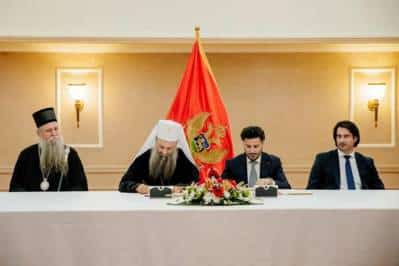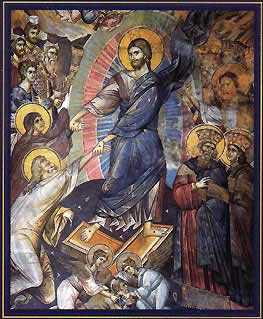The Serbian Orthodox Church has proven to be an unavoidable factor in the political and social processes of the last nearly three years in the small Adriatic republic of Montenegro. It all started in December 2019, when the ruling Democratic Party of Socialists (DPS) of Montenegrin President Milo Djukanovic pushed through the local parliament the law on religious properties, which encroached on the property of the Serbian Orthodox Church.
The arguments of Djukanović and the government in Podgorica were that this act restores a historical justice connected with the end of the First World War, when not only Montenegro, but also its territory was forcibly annexed to the Kingdom of Serbs, Croats and Slavs – Yugoslavia, and the Montenegrin Church is part of the Orthodox Church.
After the adoption of the law, the late Montenegrin Metropolitan of the Orthodox Church, Amfilochius, and his close assistant, Ep. Ioanikiy started holding daily litany processions throughout the territory of Montenegro, which had an open anti-government character. The protesters did not achieve the resignation of the then government of Duško Marković, but they succeeded in mobilizing everyone dissatisfied with the policies of Milo Djukanović, who ruled Montenegro for thirty years (with one brief exception of two years). And in the months before the regular parliamentary elections in 2020, they created a big front against him.
Thus, on August 30, 2020, Djukanović’s party was forced to step down from governing the country, because six deputies did not have the necessary forty-one votes in the Assembly out of a total of eighty and went into opposition. After several months of negotiations, the parties around Bishop Amfilohiy announced a coalition government, headed by the technocrat Prof. Zdravko Krivokapich. He himself was proposed by Amphilochius as a unifying figure for the opposition in the course of the elections. The SPC presented him as a believer who could return the controversial Law on Religions and Their Properties and restore the SPC’s place in Montenegro. However, Krivokapić’s government was never able to repeal the law due to the harsh actions of the opposition, which intensified the internal contradictions, and the partners against the rule of President Djukanović split into different camps.
Meanwhile, the influential local Metropolitan Amfilochius, a Montenegrin, died of COVID-19, and at his funeral, Serbian Patriarch Irinej contracted the disease and also died, leading to a change in the SPC. It was headed by the Zagreb-Ljubljana Metropolitan Porfiry, and in the Montenegrin-Primorska Diocese, the Metropolitan came to Ep. Ioannicius. And instead of looking for a normal solution to the problems between Montenegro and the Serbian Orthodox Church, in the fall of 2021 there was very serious tension because of the actions of the Serbian church elite to hold the enthronement of Ioanniki in Cetinje. Residents of the old Montenegrin capital Cetinje protested violently, blocking the road to the city, burning tires and erecting barricades for the enthronement of Ioannici as the new Serbian metropolitan.
Cetinje has always been considered the heart of Montenegrin statehood, which the country received after the Congress of Berlin in 1878. Ultimately, the enthronement caused tension in the Balkan state. Serbian Partiarch Porfirij and guests at the ceremony arrived in military helicopters provided by the government of Zdravko Krivokapic, which was a politically engineered product of the Serbian Orthodox Church in Montenegro, and this further raised tensions. The Serbian Orthodox Church has always perceived Montenegro as an irrevocable part of Serbia, and Montenegrin independence as a transitional element that sooner or later will be fixed and the old status quo will be restored. It will thus return either as part of Serbia or as a joint state with it, as it was until 2006, when it seceded in an internationally monitored referendum.
Many Serbian politicians in Belgrade have similar views, reaching a complete denial of Montenegrin statehood. In fact, Montenegro is central, along with the Bosnian Serbs, to plans to create a “Serbian world” in the Western Balkans along the lines of the “Russian world” promoted by the Kremlin authorities after the annexation of Crimea in 2014.
The political crisis in Montenegro led to the fall of the Krivokapić government and the creation of a new government headed by Dritan Abazović. Abazović’s desire to resolve the issue of the contract between Podgorica and the SOC led to his fall from power, as his biggest coalition partner, President Djukanović’s party, withdrew its confidence from the cabinet just four months after it was formed. According to supporters of the signing of the Basic Treaty between Montenegro and the Serbian Orthodox Church, this document formally ends decades of attacks against the only canonically recognized Orthodox Church in Montenegro. According to Prime Minister Abazović, the agreement with the SOC had to be signed in order to achieve two-thirds support and unblock reforms in the judicial system in Montenegro. Abazovic commented that anyone who wants destabilization is helping Russian influence in Montenegro and wants to “do what happened in Kosovo” in October, when local elections are scheduled in several municipalities, alluding to the blockades in the north of Kosovo.
In fact, Djukanovic spoke out against the treaty that Prime Minister Abazovic signed because it did not guarantee Montenegro’s sovereignty. In an interview with Autonomy, Djukanovic spoke quite categorically, saying that “SPC uses lies and commits historical falsifications. The SPC is the most sinister instrument of Great Serbian nationalism and Russian imperialism in the Balkans. The SPC participated in the theft of Montenegrin history”.
The SPC achieved its goal by signing the document with the authorities in Podgorica, but at too high a price – it plunged Montenegro into a serious political crisis. It is by no means certain that within the constitutional period of three months the parties in the Montenegrin parliament will agree to form a new government. But even if they succeed, it is not certain that it will last until 2024, when the regular parliamentary elections should be held. It is becoming increasingly clear that early parliamentary elections will be held in the country along with the local elections scheduled for October.
Apart from Serbia, Russia is also among the main opponents of Montenegro, because Podgorica complies with the policy of EU sanctions against Moscow due to its aggression in Ukraine. A month before it fell, Abazović’s government froze forty-four properties owned by Russian citizens in Montenegro. This was done as part of compliance with the EU sanctions regime imposed on Russia in connection with the war against Ukraine. According to local experts, Russian citizens and companies invested over 129 million euros in the Montenegrin economy last year, including 49.46 million euros in real estate that Russians bought there.
In the context of the war in Ukraine, the political instability in Montenegro is one part of the unclear political mosaic in the region that makes observers very wary. A few months ago, Montenegro and Bulgaria closed their airspace and prevented Russian Foreign Minister Sergey Lavrov from visiting Belgrade, which angered Moscow, and ten days ago the Adriatic country declared a Russian diplomat from the embassy in Podgorica “persona non grata”.
Whether the SOC will continue to interfere in the public and political processes in Montenegro remains to be seen. And the policy of Belgrade is not much different from that of the SOC, because in recent years the Serbian President Aleksandar Vucic has not visited Montenegro even once, which is taken as an attitude towards the actions of Podgorica towards the local Serbs. Belgrade actively supports the Serbs in Montenegro and has made it clear that it will not recognize the outcome of the upcoming census in the country in the fall if half of its inhabitants do not declare themselves Serbs and supporters of the Serbian Orthodox Church, which can be perceived as direct interference in its internal affairs. It is clear that Montenegro faces serious challenges both domestically and regionally, which heightens worrying expectations that the processes could spiral out of control.












